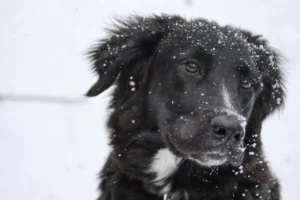We’re officially in winter now. Our four-legged friends need a little extra care to stay cozy and healthy at this time of year. Cold temperatures, snow, and icy conditions can all pose challenges for Man’s Best Buddy! However, with some thoughtful winter dog care planning, you can keep your furry companion happy and comfortable during the chilly months. A local Fayetteville, NC veterinarian offers some tips on caring for your dog during the colder months in this article.
Winter Doggy Diets
Some pooches may need to eat more than usual in cold weather. Fido’s diet may need to be adjusted a bit, as he may burn extra calories in the cold, just to stay warm. If your pooch falls into any of the following categories, check with your vet about his portion sizes.
- Senior
- Puppy
- Thin fur
- Skinny
- Nursing mama
- Working dog
Fido may also need extra food if he spends a lot of time outside. Senior dogs and pets with mobility issues may also benefit from certain supplements, like fish oil. Ask your vet for specific advice.
Grooming Your Dog In The Winter
Do you know that brushing and bathing Fido helps keep him warm? Dust, dead fur, and dander can all interfere with the insulation properties of his fur. Keep your pooch’s coat in good condition!
Of course, doggy beauty needs vary quite a bit. Do some breed research, and ask your vet or groomer about your pet’s grooming needs.
When Is It Too Cold For A Dog To Be Outside?
The trend of making it illegal to leave dogs outside in the cold is something we’re very happy to see. While specifics may vary by region, a general rule of thumb would be that Fido should never be outdoors longer than a half hour in cold temperatures.
If your furry pal has a doghouse, make sure it’s in good condition. It should be well-insulated, and the opening should face away from prevailing winds. You may want to hang thick rubber strips over the door to block the wind. However, dog house or no dog house, our canine companions should live in the house with their humans. Fido is part of the family!
What If My Dog Likes Snow?
Our canine pals are just as divided on their opinions about the cold as we are. Some pups absolutely hate it frigid weather. Others love it. Many snow dogs, such as huskies and malamutes, really enjoy playing in the snow. (Actually, if you have a husky, you may find it hard to get Fido inside.)
If your pup enjoys the cold, then by all means, let him play! Just keep a close eye on him and don’t leave him outside for too long.
Keeping Fido Warm In Winter
Make sure Fido has a comfortable bed. This will provide insulation from chilly floors, and cushion his bones and joints. Due to their extra support, orthopedic beds are perfect for larger dogs and seniors. If your canine pal shivers a lot in winter, consider getting him a pet bed warmer, thermal bed, or self-heating bed.
Of course, there’s no rule that says Fido should only have one bed. If you have enough space, get several different ones. It’s nice to have choices!
Should I Put A Jacket On My Dog In Winter?
Just like us, dogs can feel the chill of frigid temperatures, especially if they have short coats or little body fat. Consider investing in a doggy sweater or jacket to provide that extra layer of warmth during walks. This is particularly crucial for small pooches, older dogs, and breeds like Chihuahuas, who have thin fur and may not enjoy going outdoors for walks in winter.
You may need to provide your furry friend with a jacket or sweater to stay warm. Just be sure to choose one that fits comfortably and doesn’t impede your pet’s vision or mobility. Steer clear of outfits with small components like buttons, as your pup could potentially swallow them. Things with zippers should also be avoided, as they can snag on your pet’s fur.
Caring For Your Dog’s Paws In Winter
Salt, sand, ice, and chemical de-icers can all cause painful burns and abrasions on those cute toe beans. Plus, dry winter air can make your pet’s paw pads rough and cracked.
A good paw balm or wax can protect Fido’s furry feet. There are plenty of products available, but you can also make one yourself. The AKC has a simple recipe on their website. This calls for two tablespoons of coconut oil; two tablespoons of olive, sunflower, or sweet almond oil; one tablespoon of shea butter, and four teaspoons of beeswax. Combine all the ingredients in a small pot, stirring constantly. Once it’s melted, pour the mixture into either tubes or tins.
Toe fur tufts should also be trimmed back. These may be cute, but they’re a bit problematic. Aside from being very uncomfortable for Fido, these may also cause slips and strains, as they change the angle of your pet’s toes against the ground. They can also gather ice balls and/or interfere with traction.
Cleaning your pet’s paws is also important, especially if you regularly take him on walks in urban areas. City sidewalks can be covered in various hazardous substances, such as salt, chemical de-icers, and melting agents. To make this task easier, we suggest keeping pet wipes and/or a spray bottle of water and rags near the door you take Fido in and out of. Training your dog to allow you to wipe their paws in exchange for a tasty treat may be easier than you think! You may even be able to teach Fido to wipe his furry feet on a mat!
Footwear is another option. You can try putting booties on Fido, but not all dogs tolerate these. Don’t force your pet to wear them unless your vet specifically recommends it.
Lastly, use a pet-safe de-icing product. These can be found at pet stores, as well as many hardware stores.
How Can I Safely Walk My Dog In Winter?
It gets dark early in the winter months, so you may need to walk your dog at night quite often. Be extra careful when walking Fido at night. Stay in well-lit areas, and keep walks short and sweet. You may want to get a leash that has a flashlight in it.
You’ll need to take care to prevent slips and falls as well. Wear shoes or boots with good tread, and pay attention to the terrain. Snow can hide dangers like broken glass or even holes. Last but not least, keep your canine pal away from frozen bodies of water. For more information, contact your veterinarian.
Conclusion: Winter dog care is all about finding the right balance between outdoor fun and indoor warmth. By paying attention to your dog’s needs, providing the right gear, and maintaining a cozy environment, you can make winter a season of joy for both you and your furry friend. After all, a little extra care goes a long way in ensuring your dog stays happy, healthy, and warm during the winter months.
Contact us, your Fayetteville, NC animal clinic, if you have questions about your pet’s health or care! We’re here to help!





